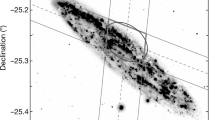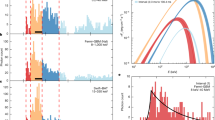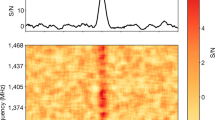Abstract
Soft γ-ray repeaters (SGRs) are ‘magnetars’, a small class of slowly spinning neutron stars with extreme surface magnetic fields, B ≈ 1015 gauss (refs 1, 2–3). On 27 December 2004, a giant flare4 was detected from the magnetar SGR 1806 - 20 (ref. 2), only the third such event recorded5,6. This burst of energy was detected by a variety of instruments7,8 and even caused an ionospheric disturbance in the Earth's upper atmosphere that was recorded around the globe9. Here we report the detection of a fading radio afterglow produced by this outburst, with a luminosity 500 times larger than the only other detection of a similar source10. From day 6 to day 19 after the flare from SGR 1806 - 20, a resolved, linearly polarized, radio nebula was seen, expanding at approximately a quarter of the speed of light. To create this nebula, at least 4 × 1043 ergs of energy must have been emitted by the giant flare in the form of magnetic fields and relativistic particles.
This is a preview of subscription content, access via your institution
Access options
Subscribe to this journal
Receive 51 print issues and online access
$199.00 per year
only $3.90 per issue
Buy this article
- Purchase on Springer Link
- Instant access to full article PDF
Prices may be subject to local taxes which are calculated during checkout



Similar content being viewed by others
References
Duncan, R. C. & Thompson, C. Formation of very strongly magnetized neutron stars: Implications for gamma-ray bursts. Astrophys. J. 392, L9–L13 (1992)
Kouveliotou, C. et al. An X-ray pulsar with a superstrong magnetic field in the soft γ-ray repeater SGR 1806–20. Nature 393, 235–237 (1998)
Woods, P. M. & Thompson, C. in Compact Stellar X-ray Sources (eds Lewin, W. H. G. & van der Klis, M.) (Cambridge Univ. Press, Cambridge, in the press); preprint at 〈http://arXiv.org/astro-ph/0406133〉 (2004)
Borkowski, J. et al. Giant flare from SGR 1806–20 detected by INTEGRAL . GCN Circ. No. 2920 (2004)
Mazets, E. P., Golenetskii, S. V., Ilinskii, V. N., Apetkar, R. L. & Guryan, Y. A. Observations of a flaring X-ray pulsar in Dorado. Nature 282, 587–589 (1979)
Hurley, K. et al. A giant periodic flare from the soft gamma repeater SGR 1900 + 14. Nature 397, 41–43 (1999)
Palmer, D. M. et al. A giant γ-ray flare from the magnetar SGR 1806 - 20. Nature doi:10.1038/nature03525 (this issue)
Hurley, K. et al. An exceptionally bright flare from SGR 1806 - 20 and the origins of short-duration γ-ray bursts. Nature doi:10.1038/nature03519 (this issue)
Campbell, P. et al. SGR1806: Detection of a sudden ionospheric disturbance. GCN Circ. No. 2932 (2005)
Frail, D. A., Kulkarni, S. R. & Bloom, J. S. An outburst of relativistic particles from the soft gamma-ray repeater SGR 1900 + 14. Nature 398, 127–129 (1999)
Kaplan, D. L. et al. Precise Chandra localization of the soft gamma-ray repeater SGR 1806–20. Astrophys. J. 564, 935–940 (2002)
Corbel, S. & Eikenberry, S. S. The connection between W31, SGR 1806–20, and LBV 1806–20: Distance, extinction, and structure. Astron. Astrophys. 419, 191–201 (2004)
Lorimer, D. R. & Xilouris, K. M. PSR J1907 + 0918: A young radio pulsar near SGR 1900 + 14 and G42.8 + 0.6. Astrophys. J. 545, 385–389 (2000)
Kouveliotou, C. et al. Multiwavelength observations of the soft gamma repeater SGR 1900 + 14 during its 2001 April activation. Astrophys. J. 558, L47–L50 (2001)
Pacholczyk, A. G. Radio Astrophysics 170–171 (Freeman, San Francisco, 1970)
Chandra, P. SGR 1806–20: Further low frequency GMRT results. GCN Circ. No. 2947 (2005)
Thompson, C. & Duncan, R. C. The giant flare of 1998 August 27 from SGR 1900 + 14. II. Radiative mechanism and physical constraints on the source. Astrophys. J. 561, 980–1005 (2001)
Thompson, C. & Duncan, R. C. The soft gamma repeaters as very strongly magnetized neutron stars. I. Radiative mechanism for outbursts. Mon. Not. R. Astron. Soc. 275, 255–300 (1995)
Rhoads, J. E. The dynamics and light curves of beamed gamma-ray burst afterglows. Astrophys. J. 525, 737–749 (1999)
Granot, J., Piran, T. & Sari, R. Images and spectra from the interior of a relativistic fireball. Astrophys. J. 513, 679–689 (1999)
Cheng, K. S. & Wang, X. Y. The radio afterglow from the giant flare of SGR 1900 + 14: The same mechanism as afterglows from classic gamma-ray bursts? Astrophys. J. 593, L85–L88 (2003)
Thompson, C. et al. Physical mechanisms for the variable spin-down and light curve of SGR 1900 + 14. Astrophys. J. 543, 340–350 (2000)
Woods, P. M. et al. Large torque variations in two soft gamma repeaters. Astrophys. J. 576, 381–390 (2002)
Wilkin, F. P. Exact analytic solutions for stellar wind bow shocks. Astrophys. J. 459, L31–L34 (1996)
Gaensler, B. M., Jones, D. H. & Stappers, B. W. An optical bow shock around the nearby millisecond pulsar J2124–3358. Astrophys. J. 580, L137–L141 (2002)
Arzoumanian, Z., Chernoff, D. F. & Cordes, J. M. The velocity distribution of isolated radio pulsars. Astrophys. J. 568, 289–301 (2002)
Staveley-Smith, L., Manchester, R. N., Kesteven, M. J., Tzioumis, A. K. & Reynolds, J. E. Structure in the radio remnant of Supernova 1987A. Proc. Astron. Soc. Aust. 10, 331–334 (1993)
Brown, J. C., Taylor, A. R. & Jackel, B. J. Rotation measures of compact sources in the Canadian Galactic Plane Survey. Astrophys. J. Suppl. 145, 213–223 (2003)
Acknowledgements
We thank J. Ulvestad, J. Wrobel, R. Sault, A. Foley and R. Vermeulen for rapid scheduling of the VLA, ATCA and WSRT; T. DeLaney, G. de Bruyn and C. Brogan for assistance with data analysis; and R. Manchester, D. Frail and M. Wieringa for help with the observations. NRAO is a facility of the NSF operated under cooperative agreement by AUI. The Australia Telescope is funded by the Commonwealth of Australia for operation as a National Facility managed by CSIRO. The MOST is operated by the University of Sydney and supported in part by grants from the ARC. The WSRT is operated by ASTRON with financial support from NWO. B.M.G. acknowledges the support of NASA through a Long Term Space Astrophysics grant. D. E. acknowledges support from the Israel–US BSF, the ISF and the Arnow Chair of Physics. Y.E.L. acknowledges support from the German-Israeli Foundation. R.A.M.J.W. and A.J.H. acknowledge support from NWO.
Author information
Authors and Affiliations
Corresponding author
Ethics declarations
Competing interests
The authors declare that they have no competing financial interests.
Supplementary information
Supplementary Table S1
This table lists the flux density of the transient radio source coincident with SGR 1806-20 as a function of both time and frequency. The techniques used to make these flux density measurements are also described. (PDF 26 kb)
Rights and permissions
About this article
Cite this article
Gaensler, B., Kouveliotou, C., Gelfand, J. et al. An expanding radio nebula produced by a giant flare from the magnetar SGR 1806–20. Nature 434, 1104–1106 (2005). https://doi.org/10.1038/nature03498
Received:
Accepted:
Issue Date:
DOI: https://doi.org/10.1038/nature03498
This article is cited by
-
Magnetar spin-down glitch clearing the way for FRB-like bursts and a pulsed radio episode
Nature Astronomy (2023)
-
An extreme magneto-ionic environment associated with the fast radio burst source FRB 121102
Nature (2018)
-
Pulsar-Wind Nebulae and Magnetar Outflows: Observations at Radio, X-Ray, and Gamma-Ray Wavelengths
Space Science Reviews (2017)
-
Pulsars and Magnetars
Brazilian Journal of Physics (2013)
Comments
By submitting a comment you agree to abide by our Terms and Community Guidelines. If you find something abusive or that does not comply with our terms or guidelines please flag it as inappropriate.



